By David J. Cord
Bonobos are omnivorous frugivores, meaning they eat everything but depend heavily on fruit. Their diet is based on the flora and fauna of their home in the Democratic Republic of Congo, but people everywhere could take a few lessons from them for what we eat, too. A bonobo-style diet could make us happier and healthier, as well as be better for the planet and our local communities.
Load up on fruit

Bonobos love fruit. When it is plentiful, it can make up over half of a bonobo’s diet. One of their favorites sources of food are Dialium trees, which produce grape-sized brown fruits called velvet tamarind. Figs are also popular: a large fig tree can keep an entire group occupied for several days. Other sources are sugar plum (Uapaca guineesis), which produce small green fruit, and Pancovia laurentii, which has clusters of berry-sized orange-yellow fruit. Anonidium mannii, sometimes called junglesop, produce giant fruits. This fruit is loaded with Vitamin A and can weigh as much as 15 kg (33 pounds), which is huge for a 60 kg (132 pounds) bonobo!
Doctors and nutritionists have been telling us for decades we should eat more fruit and vegetables, so this is an easy improvement to our diet. Check out your neighborhood farmers’ market and load up on fresh fruits and vegetables from your area.
A healthy diet includes greens

The second biggest part of the bonobo’s healthy diet is what the experts call Terrestrial Herbaceous Vegetation, or THV. Leaves and young shoots are the biggest portion of this, but bonobos will also eat pith, the soft tissue in stems of plants, as well as seeds and flowers. This may make up about 30% of a wild bonobo’s diet.
At Lola ya Bonobo sanctuary, the on-site farm grows sweet potato leaves (and more) for resident bonobos. Called matembele in Lingala, a cooked version is a popular Congolese dish. Other common leaf vegetables for humans are lettuce, spinach and kale. More ideas could be cabbage, fennel, chard, leeks, chicory, dandelion, beetroot, watercress and sorrel. You could round off this course with bean shoots and nuts.
Small portions of meat

Chimpanzees are famous hunters, but bonobos also eat meat on occasion. Meat could be a good source of protein for them. They don’t eat much: one study suggests a bit more than 3% of their diet is meat, typically squirrels, monkeys, birds and the small forest antelope called duiker.
As we know, meat can be a problematic food for humans. The production of meat is harmful to the environment and eating a lot of meat, particularly red and processed meat, is linked to poor health. You don’t need to give up your steaks, though. If you want to eat meat like a bonobo, just eat it in moderation and avoid the ultra-processed stuff.
What’s for dessert?

Bonobos are opportunistic eaters and about 3% of their diet is made up of a hodgepodge of foods. They have been documented eating honey, termites, mushrooms and insect larvae which could provide nutrients they don’t get in other foods. In one case, researchers watched a bonobo eat a butterfly!
All of these foods (except perhaps for butterflies) are also eaten by humans. In fact, there might be health benefits for many of them, like insects, honey and mushrooms.
Diversify your dinners
Bonobos have been documented eating over 110 species of plants. On average, they might eat 10 different plants a day and 40 different ones per month. This is a good idea for us, too.
Some studies suggest that a varied diet can make us mentally and physically healthier.
A diverse, healthy diet also improves our gastrointestinal microbiome, or gut health.
Eat local
If you want to eat like a bonobo, eat local and take advantage of seasonal food. Wild bonobos eat food from their area, and there are benefits to us doing this, too. By doing this we reduce transportation costs and emissions, as well as support the farmers in our local communities. Bonobos go even farther to support their local environment: because they eat so much seedy fruit, they when they defecate they effectively replant the forest. They’re gardeners of the forest!
Eat slow
“Slow Food” might be a newer concept for us, but bonobos have always eaten like this. About 18% of a bonobo’s time is spent feeding in trees, and about 20% is spent traveling and eating as they go. This means they could spend up to 9 hours a day looking for food and eating it.
This is a bit much for a busy person, but we can still take some lessons from our nearest relatives. Put some time and effort into your food and invite a friend to prepare and eat it with you. After all, just like bonobos, we’re social animals.

Learning to forage
This article concerns what wild bonobos eat. The rescued bonobos of Lola ya Bonobo sanctuary have a different menu. Collectively they consume more than 136,000 kg (300,000 pounds) of food each year! Their diverse diet includes leafy greens, watermelon, banana, pineapple, avocado, cucumber, African pear and palm nuts. The keepers also provide protein balls made from a mixture of lentils, bananas, squash, sesame seeds and wheat, maize or cassava flour.
Most of Lola’s bonobos have seen their mothers killed, so there was no one to teach them what forest plants to eat.
At Lola ya Bonobo, we aim to teach endangered bonobos how to thrive on their own and to release as many as possible back to the wild.
Sources cited:
- https://nagonline.net/wp-content/uploads/2013/12/Bonobo-Nutrition1.pdf
https://www.researchgate.net/publication/256303376_The_Ecological_Role_of_the_Bonobo_Seed_dispersal_service_in_Congo_forests
https://www.pnas.org/doi/full/10.1073/pnas.1018502108
https://www.researchgate.net/publication/256303376_The_Ecological_Role_of_the_Bonobo_Seed_dispersal_service_in_Congo_forests
https://www.un.org/en/climatechange/science/climate-issues/food
https://journalofethics.ama-assn.org/article/meat-and-health/2023-04
https://www.pnas.org/doi/full/10.1073/pnas.1018502108
https://pubmed.ncbi.nlm.nih.gov/33397123/
https://www.ncbi.nlm.nih.gov/pmc/articles/PMC5424551/
https://www.ncbi.nlm.nih.gov/pmc/articles/PMC4320875/
https://nagonline.net/wp-content/uploads/2013/12/Bonobo-Nutrition1.pdf
https://bmcpublichealth.biomedcentral.com/articles/10.1186/s12889-024-18172-y
https://www.ncbi.nlm.nih.gov/pmc/articles/PMC4837298/
https://ielc.libguides.com/sdzg/factsheets/bonobo/behavior
David J. Cord is the author of five books and has been published in 10 languages. As a journalist he covers Nordic innovations and public policy for an international audience. He is a firm believer in nature conservation and thinks bonobos can teach us a lot about ourselves.

 Kendra is a creative problem-solver who excels in leading end-to-end project delivery with a focus on clear goals and timely execution. She provides support to FOB’s development and communications teams and serves as assistant to the Executive Director. Originally from Panamá, Kendra is an avid traveler. She is proud to support bonobo conservation not only for the well-being of bonobos but also because it helps protect our planet.
Kendra is a creative problem-solver who excels in leading end-to-end project delivery with a focus on clear goals and timely execution. She provides support to FOB’s development and communications teams and serves as assistant to the Executive Director. Originally from Panamá, Kendra is an avid traveler. She is proud to support bonobo conservation not only for the well-being of bonobos but also because it helps protect our planet. Amanda makes connections with FOB’s major donors. She has worked in the nonprofit sector for her entire career and found her passion for animal rights and conservation as a volunteer fundraiser for a local dog rescue. She finds that FOB coalesces multiple causes – environmental, animal rights, and community engagement. While protecting bonobos first drew her to FOB, she’s learned how we, as humans, are connected to the environment and to the bonobos that we strive to protect.
Amanda makes connections with FOB’s major donors. She has worked in the nonprofit sector for her entire career and found her passion for animal rights and conservation as a volunteer fundraiser for a local dog rescue. She finds that FOB coalesces multiple causes – environmental, animal rights, and community engagement. While protecting bonobos first drew her to FOB, she’s learned how we, as humans, are connected to the environment and to the bonobos that we strive to protect. Kathleen Cook brings more than eight years of experience working across Africa, with a focus on the Democratic Republic of Congo, where she has traveled over twenty times to support projects spanning conservation, clean energy, and community development. Her career has centered around using storytelling, strategic marketing, and relationship-building to create meaningful impact.
Kathleen Cook brings more than eight years of experience working across Africa, with a focus on the Democratic Republic of Congo, where she has traveled over twenty times to support projects spanning conservation, clean energy, and community development. Her career has centered around using storytelling, strategic marketing, and relationship-building to create meaningful impact.
